Another month gone means another month spent in the garden. It also means I have a lot to show you all! I'll try to make this painlessly brief, but packed with information and delights.
First off, I gotta confess I am not a fan of eating garlic scapes. I really don't get them. But I was told I should chop off the scapes so that the energy goes into developing the garlic bulbs. Off with their heads! The scapes were so pretty, I stuck them in a vase, and boy did they make a lovely, long lasting, flower arrangement.
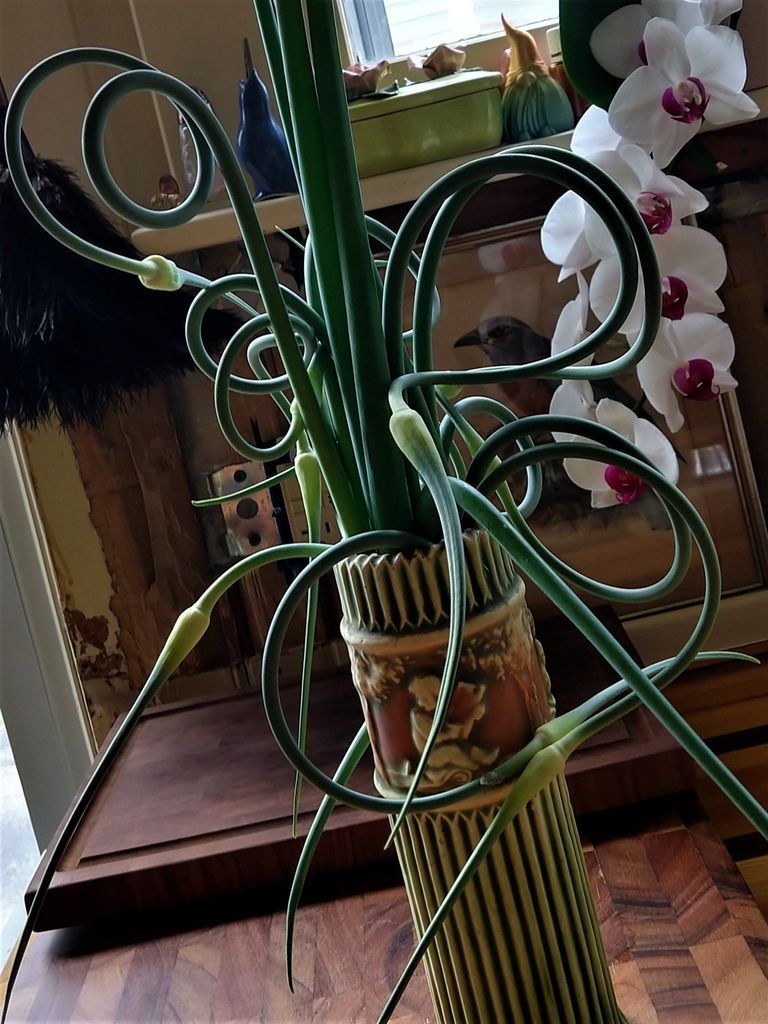

I've had several big firsts in this year's garden, but the most spectacular of these have been in flowers, especially delphinium and poppy. I have never had enough sun to grow delphiniums, but boy have they come out for me this year! These flower spikes are a good six feet tall! Poppies have also never grown well for me several times before this; I have never achieved even one single flower. I'm so happy with this year's turn out! The blooms last all of one day, and I was very lucky that these all bloomed at once. Goodness were they ever gorgeous! Many more of this variety, and of two others, are on their way to glory too. I just hope I'm here on the days it happens.
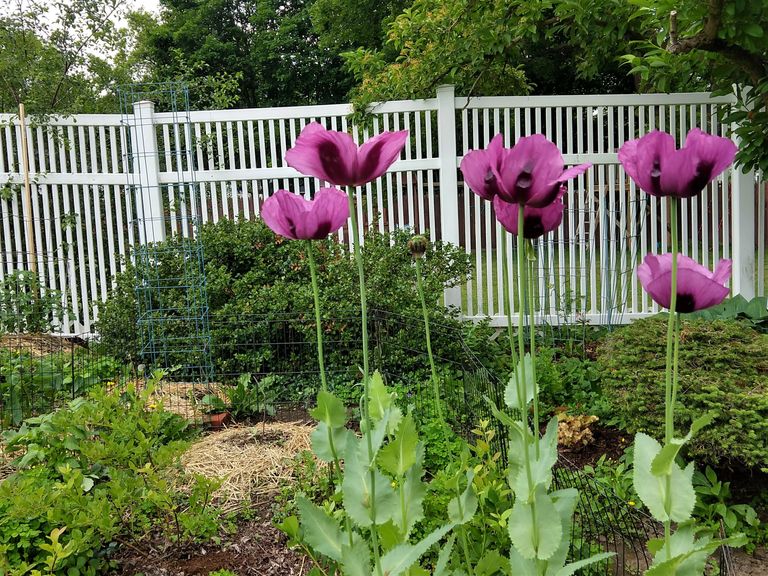
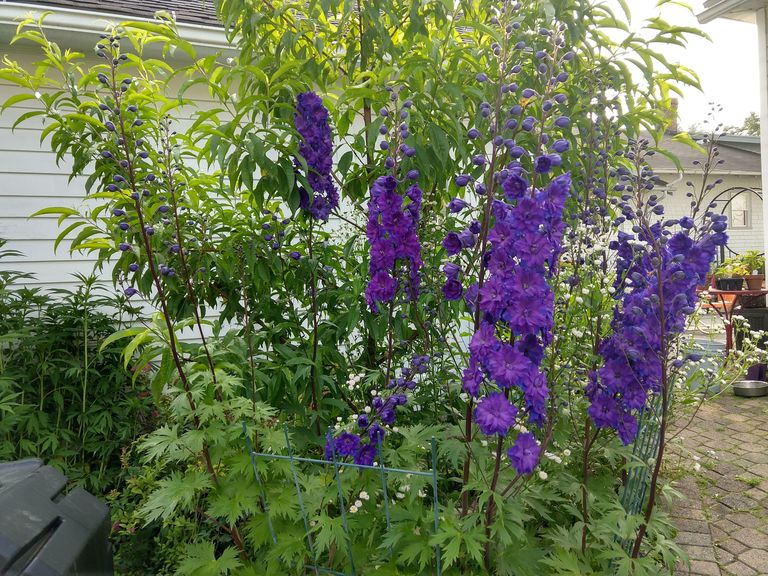

Veggies that I have never been able to grow before are also doing very well for me here. I believe I might be able to say that I am getting the hang of this veggie gardening thing!
I LOVE shell peas, love love love. But only if they are fresh from the garden. Long ago, my Aunt Jane taught me to get the water boiling while we shelled the just-picked peas, so that we would be eating them at their sweetest. I am so looking forward to doing this with the great pea harvest I should have in a couple days and thereafter for a while. Unfortunately, I am going away for a few days, just when these will begin to be fully ripe, so I'm going to have to pick and chill all those that are just beginning to plump just before I get in the car tomorrow.
I tried very early plantings of beets and carrots under a hoop house this spring, and have harvested all of them. The experiment was pretty much a success, except that the beets didn't really get ready much earlier than a row I planted more than a month later, without any protection from the cold. Next year I might only do carrots under the hoop house, and more of them. It's been lovely to have those to munch on, but they're nearly gone. I did manage to pickle four pints of beets and onions. That was so much work!!! I'm not sure I'll ever do that again, or maybe I'll just pickle little baby beets so I don't have to peel them. And maybe I'll forget I even said this, and spend another full afternoon pickling four pints of beets next year too.
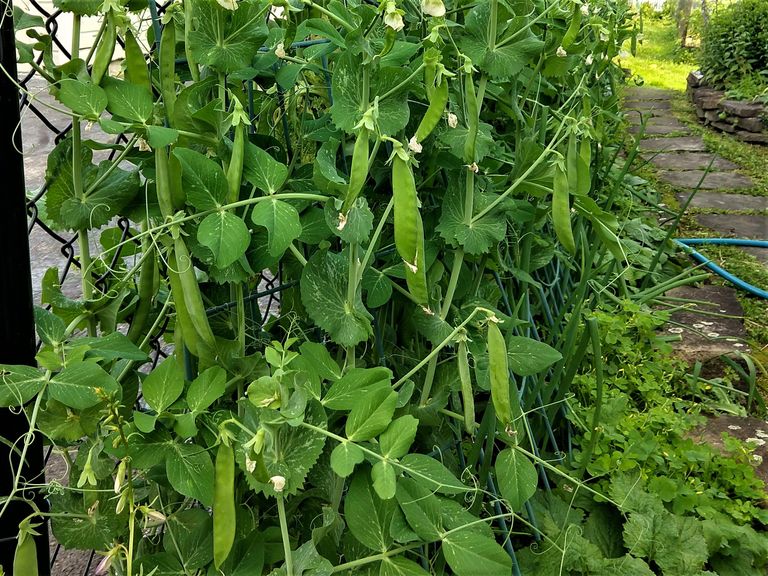
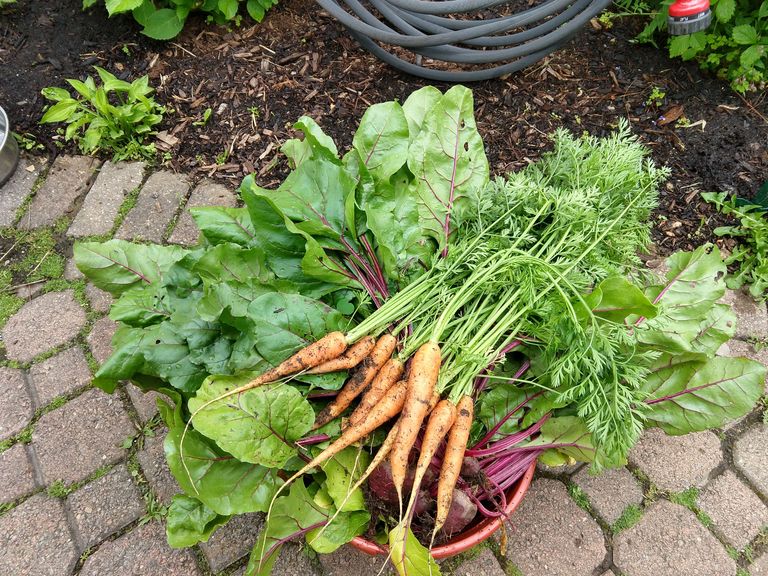

Ingenuity is not always a good thing. This is evident in my cucumber patch, in which I tried a new fangled, self-devised, technique this year. My idea was to get the vines growing up short fences around the plants, rather than letting them spread out or grow up actual trellises. I figured they'd go west toward the afternoon sun, so that it would be easy for me to lean over the short fence on the east side to snag the cukes, but of course the vines are going east and obscuring my view of, and access to, the fruits. There are lots and lots of tiny cukes coming along nicely, and I know the plants are healthy and productive, but it won't be easy harvesting those fruits. Oh well. There's always next year's ingenious idea.
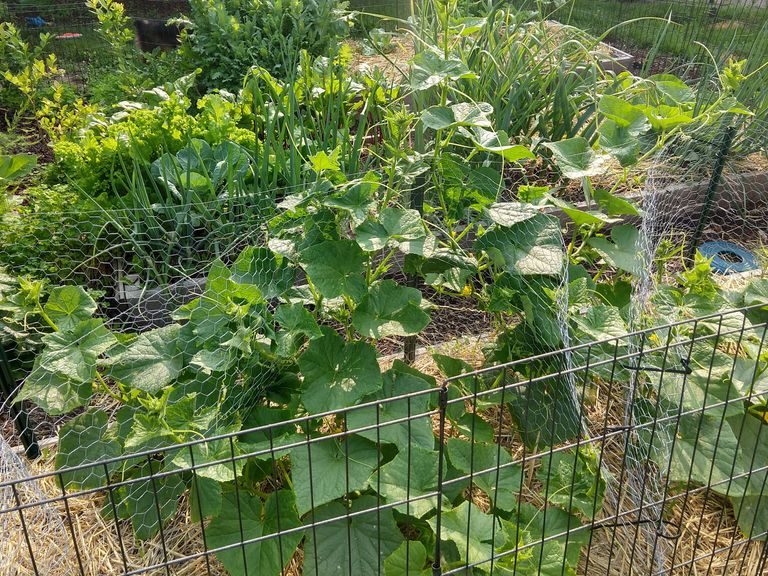
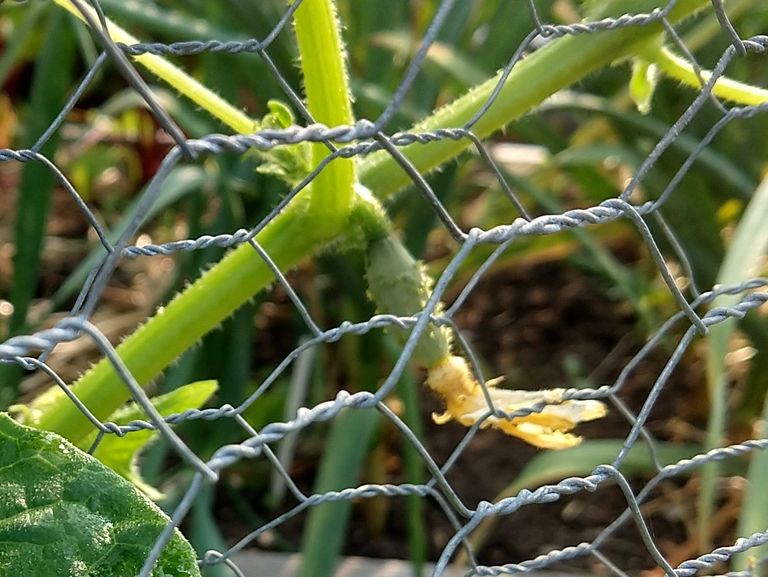

I've had some problems of course. Something ate my pole bean seedlings as soon as they emerged from the ground. Aphids are all over the tips of my crab apple tree, and just today I discovered some black beetles in patches on my poppies. I haven't managed to identify these yet. If you know what they are, please let me know. I believe they are too late to be flea beetles, and they are on poppy leaves, which is unusual for flea beetles. They are also in these odd clumps.
I tried first spraying the crab apple tree with water to knock the bugs off (hopefully that doesn't just spread them around) and then spraying the crab apple with a mixture of water, castile soap, neem oil, and clove and rosemary essential oils. This doesn't seem to have done much.
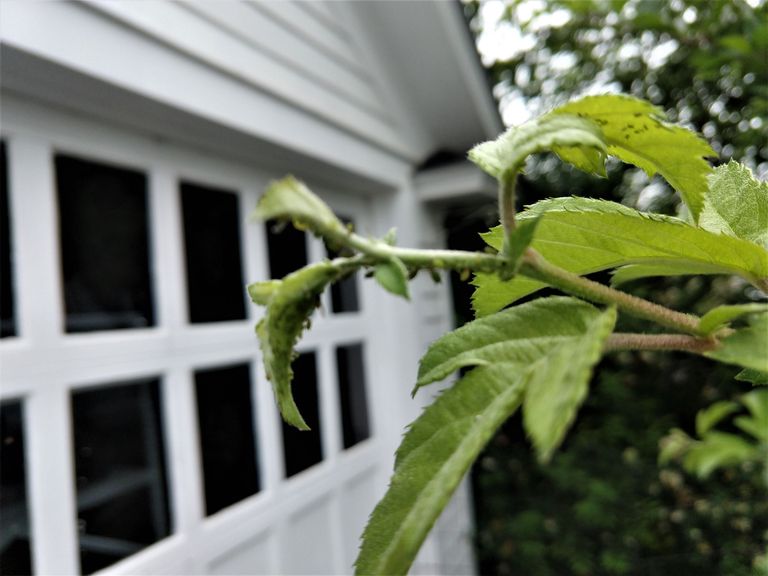
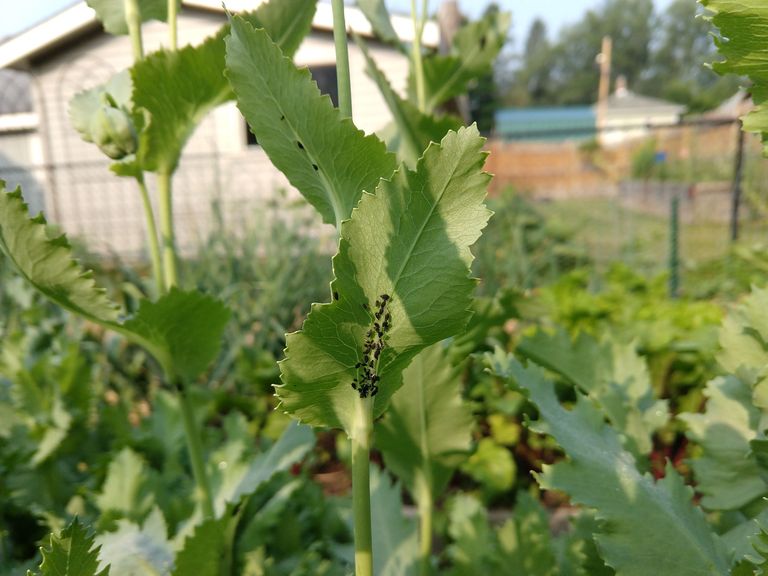

What I haven't shown you this time!
Potatoes, both sweet and golden butterballs, are super healthy looking. Cabbages, peppers, eggplant, okra, lettuce, mustard greens, garlic, zucchini, watermelon, tomatoes, raspberries, blueberries, peaches, onions, leeks, shallots, lots of herbs, and more beets! The nightshades are battling the onslaught of pests far better than they all did last year, possibly because I have spread them out more, sprayed with my mixture if I saw any problems, and, most excitingly, I put copper spirals next to most of my seedlings when I first planted them. I didn't do this systematically enough to be sure, but I believe the plants with spirals are doing much better than those without. This is most evident in my three cabbages. The three cabbages form a line in the shot, one of them in the second bed, and two in the bed in front. I hope you can see that the cabbage in the back is doing much better than the other two, and that one in the back had a spiral next to it from the first day I planted it. Look for a post about these copper spirals soon.
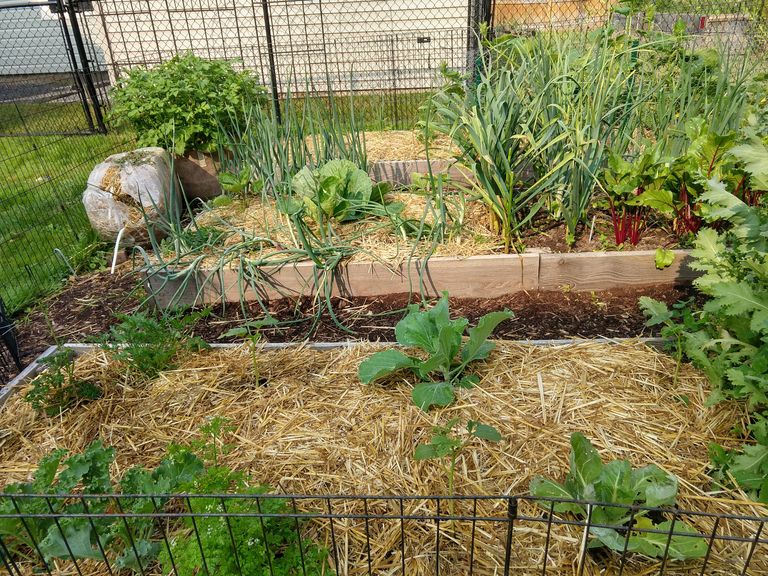

What drives us to grow our own food? It's not for any savings in money, at least not the way I do it. I've spent at least $200 on dirt alone this year! It's sure not to save any time; I work my butt off out there, even in this tiny garden, that is now miraculously producing more than I can eat myself. It's not for the prettiness, veggie gardens can often appear to be a mess. So why do we do it?
The food tastes better, is fresher, we know exactly what chemicals have been used on it, and is no doubt more nutritious. What, however, is nutrition? Is it a collection of identified chemical compounds found in our foods by impersonal labs, and industry funded scientists? Or are there as yet unidentified nutrients? I posit that there is a class of nutrients that cannot be measured, nutrients of love. Foods grown by your own hand, or the hands of others who love you, provide a whole slew of love medicine.
Grow Your Own!

This was my entry to Hive Garden Community's for July, 2023 on that other chain.

Upvoted by @ultravioletmag
Thank you!
Great job! You're doing excellent this year. I liked your garlic bouquet!
Peas right from the garden are best! Well, everything right from the garden is best. Fresh is (almost) always better than stagnant. Fresh produce needs less cooking in order to be tender and edible... leaving it even more nutritious (since cooking generally removes nutrients). And of course raw veg is great for our guts and blood.
For aphids, I generally just outgrow them. They are nothing more than leeches, stealing a bit of plant blood (like vegan mosquitos). They don't poison your plants, they don't eat very much of the plants, they don't leave nasty holes or poop behind. They just drain. So to combat that, I just make my plants as healthy and big as possible, minimizing the relative loss from the aphids. You can also mechanically remove them by hand, or with water as you've tried doing. Spreading them around is a good thing, so don't worry about doing that. I often go over my tomato plants by hand, brushing off and squishing as many as I can, and then just let them outgrow the bug problem. Also, keep in mind that weather hugely impacts bug life cycles and populations. Sometimes all you have to do is wait, and the weather shifts, and a bug problem completely disappears. Other times, the weather changes, and a natural predator hatches for the season, taking care of your problem. Sometimes the right move is to wait, even though it's hard when we see pests on our precious plants!
My grandparents had 2 large delphiniums in the back garden I took care of for several years. When he was gone, she said they reminded her of him. I kept them happy each year and they produced massive amounts of flowers and seeds. I kept a lot of the seeds, but have tried planting them since, with no results. I don't think delphinium seeds last very long. The honeybees sure came to visit the garden because of those 2 plants!
I wonder if the copper spirals are being used on commercial farms yet? I keep hearing small-time growers saying they work great, but I have to imagine it could be scaled up. Anything that increases yield with no additional fertilizer or light is welcomed by the industry! Maybe it will lead to more organic produce being grown, and better prices?
Speaking of that, you're right that we don't do it for the money. In fact, it generally COSTS us to grow this food, and would be cheaper at the supermarket! Your reasons given for doing it anyway are bang on.
Remember to let part of your harvest flower out so you can collect next year's seeds!
Keep on growing.
I love that idea to wait it out sometimes. I did try to do that last year with my eggplants and peppers, which were being eaten to lace by a small black beetle, but the strategy didn't work - I did not have a single pepper or eggplant flower, let alone fruits. Not one! That year, I had filled my raised beds with pure composted cow manure, which I think was a mistake. Nothing was really healthy. This year, I dug most of that out and refilled the beds with a high quality soil mix, and the results have been much better! EVen tho the japanese beetles are messing with my eggplants, they have lots of flowers, unlike last year. The peppers are not being bothered by the beetles, and they have lots of flowers too. Very exciting to see myself producing more and more each year.
You're honing skills that will be useful to you for the rest of your life, and that you can share with others. Think how much better next year will be, after all you're learning now! I think it's going to be even more impressive. Keep up the great work!!
I never cut off the scapes, maybe that is why my bulbs are so puny
This is my first year growing garlic, but I was told that the bulbs would get bigger if I cut the scapes off.
I will try it. I never really knew what the scapes were for 😂
People eat them, but I don't find them very appetizing. I line the bottom of a roasting pan with them sometimes.
On your comment about ingenuity: sometimes discover what does not work is crucial for discovering what does.
It sure provides unforgettable lessons! A cucumber prickle lodged itself in my eye and it still hurts something awful more than a year later. I tried a bunch of rnatural emedies for this (colloidal silver, topical comfrey tincture, DMSO) to no avail with continued excruciating pain at night in bed. But my latest attempt, homeopathy, seems to have done the trick!